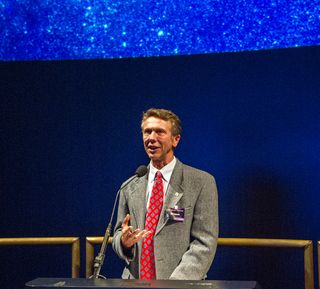
NASA Renames Swift Observatory in Honor of Late Principal Investigator

NASA officials announced today (Jan. 10) that the agency's Swift Gamma Ray Burst Explorer spacecraft has been renamed in memory of the mission's original principal investigator, Neil Gehrels, who passed away in February 2017. The space-based telescope, which launched in 2004, will now be known as the Neil Gehrels Swift Observatory.
"During his career, Neil wore many hats in service to the astrophysics community," Paul Hertz, director of NASA's Astrophysics Division, said today during a press conference at the 231st meeting of the American Astronomical Society in Washington, D.C. "But Neil was best-known for his role as the principal investigator of the Swift mission," Hertz said.
The Swift spacecraft was designed to be able to quickly and autonomously turn itself toward objects that are moving rapidly through the sky, or brightening and dimming in the sky on short timescales. Traditionally, astronomers have observed phenomena that change on incredibly long timescales, so this new approach was dubbed "time domain astronomy." Swift's original two-year mission was to uncover the nature of gamma-ray bursts, or the then-unexplained flashes of very high-energy light that are seen throughout the universe.
"In the years since its prime mission ended, Swift has been used as the go-to facility for [studying] transient and variable cosmic phenomena of all kinds," Hertz said. "Neil's vision and leadership were critical in ushering in the new era of time domain astronomy."
Gehrels served as principal investigator of Swift up until his death last year. He also served as the chief of the Astroparticle Physics Laboratory at NASA's Goddard Space Flight Center. In addition, he was a project scientist for the Compton Gamma-ray Observatory; for its successor, the Fermi Gamma-ray Space Telescope; and for NASA's upcoming Wide Field Infrared Survey Telescope (WFIRST), which is expected to launch in the early 2020s.
Follow Calla Cofield @callacofield. Follow us @Spacedotcom, Facebook and Google+. Original article on Space.com.
Get the Space.com Newsletter
Breaking space news, the latest updates on rocket launches, skywatching events and more!
Join our Space Forums to keep talking space on the latest missions, night sky and more! And if you have a news tip, correction or comment, let us know at: community@space.com.

Calla Cofield joined Space.com's crew in October 2014. She enjoys writing about black holes, exploding stars, ripples in space-time, science in comic books, and all the mysteries of the cosmos. Prior to joining Space.com Calla worked as a freelance writer, with her work appearing in APS News, Symmetry magazine, Scientific American, Nature News, Physics World, and others. From 2010 to 2014 she was a producer for The Physics Central Podcast. Previously, Calla worked at the American Museum of Natural History in New York City (hands down the best office building ever) and SLAC National Accelerator Laboratory in California. Calla studied physics at the University of Massachusetts, Amherst and is originally from Sandy, Utah. In 2018, Calla left Space.com to join NASA's Jet Propulsion Laboratory media team where she oversees astronomy, physics, exoplanets and the Cold Atom Lab mission. She has been underground at three of the largest particle accelerators in the world and would really like to know what the heck dark matter is. Contact Calla via: E-Mail – Twitter
